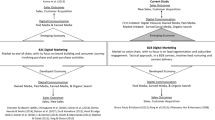Abstract
While many scholars have studied the impact mergersand acquisitions have had on market concentrationlevels in various industries, few have addressed theconsumer book market, an important U.S. culturalindustry. This paper: (1) defines the consumer bookmarket; and (2) using consumer book mergers, salesdata, the U.S. Department of Justice's 1992 mergerguidelines, the Herfindahl–Hirschman Index, andfour-firm and eight-firm concentration ratios testswhether an illegal level of market concentration or aviolation of Justice's antitrust guidelines wereevident in 1995 and 1996. Data on market entrybarriers, outputs, and prices are also analyzed.
Similar content being viewed by others
References
Aufderheide, P. (1997) “Telecommunications and the Public Interest”, in E. Barnouw (ed.), Conglomerates and the Media. New Press, New York.
Auletta, K. (1997) “The Impossible Business”. The New Yorker 6 October: 50, 52, 54–56, 59–60, 62–63.
Bagdikian, B.H. (1997) The Media Monopoly (5th edn.). Beacon Press, Boston.
Bagdikian, B.H. (1989) “The Lords of the Global Village: Cornering Hearts and Minds”. The Nation 12 June: 805, 807–808, 811.
Blair, R.D. and Romano, R.E. (1997) “Identifying Participants in a Price-Fixing Conspiracy: Output and Market Share Tests Reexamined-Reply”. Review of Industrial Organization 12 (2): 291–294.
Bogart, D. (1998) The Bowker Annual 1998. R.R. Bowker, New Providence, NJ.
Book Industry Study Group (1997) Book Industry Trends 1997. Book Industry Study Group, New York.
Bork, R.H. (1978) The Antitrust Paradox: A Policy at War with Itself. Basic Books, Inc., New York.
Brozen, Y. (1979) “The Concentration-Collusion Doctrine”, in E.M. Fox and J.T. Halverson (eds.), Industrial Concentration and the Market System. American Bar Association, Chicago, pp. 90–120.
Campisi, D., Mancuso, P., and Nastasi, A. (1997) “Cost Reduction, Competitive Pressure and Firms' Optimal R&D Strategies in a Duopolistic Industry”. Review of Industrial Organization 12 (2): 259–270.
Cohen, R.M. (1997) “Conglomerates and Newspapers”, in E. Barnouw (ed.), Conglomerates and the Media. New Press, New York.
Coser, L.A., Kadushin, C., and Powell, W.W. (1985) Books: The Culture and Commerce of Publishing. University of Chicago Press, Chicago.
Cowles/Simba Information (1997) “20 Leading U.S. Consumer Book Publishers, Revenues and Market Share, 1996”, Trade Book Publishing, 1997. Cowles/Simba Information, Stamford, CT, p. 11.
Demsetz, H. (1982) “Barriers to Entry”. American Economic Review 72 (March): 47–57.
Emmons III, W.M. and Praeger, R.A. (1997) “The Effects of Market Structure and Ownership on Prices and Service Offerings in the U.S. Cable Television Industry”. Rand Journal of Economics 28 (4): 732–750.
Ford, G.S. and Jackson, J.D. (1997) “Horizontal Concentration and Vertical Integration in the Cable Television Industry”. Review of Industrial Organization 12 (4): 501–518.
Gitlin, T. (1997) “Introduction”, in Erik Barnouw (ed.), Conglomerates and the Media. New Press, New York.
Greco, A.N. (1997) The Book Publishing Industry. Allyn and Bacon, Boston.
Greco, A.N. (1996) “Shaping the Future: Mergers, Acquisitions, and the U.S. Publishing, Communication, and Mass Media Industries, 1990–1995”. Publishing Research Quarterly 12 (3): 5–15.
Guiltinan, J.P and Gundlach, G.T. (1996) “Aggressive and Predatory Pricing: A Framework for Analysis”. Journal of Marketing 60 (July): 87–102.
Hay, D.A. and Liu, G.S. (1997) “The Efficiency of Firms: What Difference Does Competition Make?”. The Economic Journal 107 (May): 597–617.
Heil, O.P. and Langvardt, A.W. (1994) “The Interface Between Competitive Market Signaling and Antitrust Law”. Journal of Marketing 58 (July): 81–96.
Hirsch, Paul M. (1985). 'U.S. Cultural Productions: The Impact of Ownership,' Journal of Communication 35 (Summer): 110–121.
Jung, C. and Seldon, B.J. (1995) “The Degree of Competition in the Advertising Industry”. Review of Industrial Organization 10 (1): 41–52.
Karaslan, M.E. (1997) “Identifying Participants in a Price-Fixing Conspiracy: Output and Market Share Tests Reexamined”. Review of Industrial Organization 12 (2): 279–290.
Lacy, S. (1984) “Competition among Metropolitan Daily, Small Daily, and Weekly Newspapers”. Journalism Quarterly 61 (Winter): 640–644.
Lacy, S. (1985) “Monopoly Metropolitan Dailies and Inner-City Competition”. Journalism Quarterly 62 (Winter): 639–644.
Miller, M.C. (1996) “Free the Media”. The Nation 3 June: 9–15.
Miller, M.C. (1997) “The Publishing Industry”, in Erik Barnouw (ed.), Conglomerates and the Media. New Press, New York.
“995 M & A Profile” (1996) Mergers and Acquisitions March/April: 37–49.
NPD Group, Inc. and Meyer, C. (1997) 1997 Consumer Research Study on Book Purchasing. American Booksellers Association and the Book Industry Study Group, Inc., New York.
Paroush, J. (1995) “The Effect of Merger and Acquisition Activity on the Safety and Soundness of a Banking System”. Review of Industrial Organization 10 (1): 53–67.
Peters, J. (1992) “Book Industry Statistics from the R.R. Bowker Company”. Publishing Research Quarterly 8 (3): 12–23.
Pitofsky, R. (1991) “Does Antitrust Have a Future?”, in H. First, E.M. Fox, and R. Pitofsky (eds.), Revitalizing Antitrust in Its Second Century: Essays on Legal, Economic, and Political Policy. Quorum Books, New York, pp. 530–537.
Pitofsky, R. and Klein, J.I. (1998) “There's More to a Monopoly than Market Share”. Business Week 13 April: 10.
Posner, R.A. (1976) Antitrust Law: An Economic Perspective. University of Chicago Press, Chicago.
Sullivan, L.A. (1977) Handbook of the Law of Antitrust. West Publishing Co., St. Paul, MN.
Taylor, W.E. and Taylor, L.D. (1993) “Postdivestiture Long-Distance Competition in the United States”. American Economic Review 83 (May): 185–190.
United States, Department of Commerce, Bureau of the Census (1997) The Statistical Abstract of the United States 1997. USGPO, Washington, D.C.
United States, Department of Justice (1997) The Department of Justice Manual, Vol. 6, Title 7: Antitrust Division Part 1. Aspen Law and Business, Englewood Cliffs, NJ.
Viscusi, W.K., Vernon, J.M., and Harrington, Jr., J.E. (1995) Economics of Regulation and Antitrust. M.I.T. Press, Cambridge.
Wirth, Michael O. and Bloch, Harry (1995) “Industrial Organization Theory and Media Industry Analysis”. Journal of Media Economics 8 (2): 15–26.
Rights and permissions
About this article
Cite this article
Greco, A.N. Market Concentration Levels in the U.S. Consumer Book Industry: 1995–1996. Journal of Cultural Economics 24, 321–336 (2000). https://doi.org/10.1023/A:1007654222498
Issue Date:
DOI: https://doi.org/10.1023/A:1007654222498




